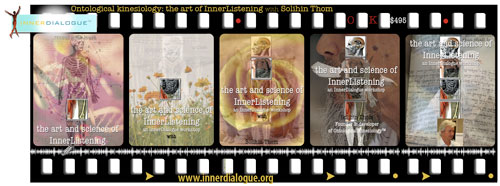InnerListening™ : the practice of a true dialogue
This workshop offers the opportunity to widen practitioner interpersonal skills by providing the collective field to enhance, open and be receptive to resonant signals:
Signals: information carried at a particular wavelength
Transference is a much-hyped word in certain psychological circles, that originated from Freud and infers that in a therapeutic modality, we, as practitioners may receive empathetic states that originate from the client. Conversely, counter-transference is when we as practitioners project and entangle our own states onto that of the client. As practitioners, we have to be ever mindful of how we may place our own reality upon our subjects, and likewise, the client has the capacity to allow us to see what they want us to see! In InnerDialogue we have to some degree, addressed this particular problem by being attentive to a broadcast force that resonates with our own overt or subconscious shadow elements. At this implicit level, the hand mode called reciprocal force helps us to know when we are held in this primary enmeshed state, whether it is from or to the client. In a similar way, the mode reciprocal narrative also warns us, that the practitioner has a similar story and may collude, may be swayed or nuanced by the narrative, be biased towards, or become a partner to the story. This may shackle us to them and create a bond, hidden of course, which enslaves us in a therapist-client modality from which it is often hard to escape and certainly creates a collusion whose end result is never satisfactory.
However, there are other levels of transference which InnerListening models after. This is the sub-dialogue that occurs whilst we work with a client. This sub or hidden dialogue may occur:
[1] before we meet the client – if our inner apparatus is finely tuned
[2] as we are first introduced
[3] during our initial entry procedure
[4] more often, later in the session
[5] through direct Higher guidance.
You may see in this classification that we have an ontological premise behind signal epigenesis.
Those moments, when a signal appears on or in our body, and in a similar vein possibly mirrored in the body of the client, are important, because we often, when the signal is out of context, dismiss the signal as an itch, an ordinary moment of unease, discomfort or when the familiarity of the signal is part of our own inner vocabulary. This prescient signal can allow us to ‘know’ something about the client who is about to appear, or who we are now facing.
Signals are carried through the ethers (air) and are received by us through our different lenses. These lenses are our different antennae and filters which we use to screen incoming data. We have many parts of our body that act as antennae, and this is probably why some practitioners have a limited gamut of signals because they receive through a single or particular antenna and/or filter. Our body is a beautiful piece of technology, albeit organic! Because we retain aspects of our phylogenetic past we contain the remnants of the lower species through which we have evolved and have incorporated aspects of their functionality within ourselves.
Direct receiving from a Higher Source can direct us to a larger nous, something out of our range of broadcast or abilities. These moments occur because of our inner state of openness and surrender, where signals appear from Grace rather than from the broadcast. Our body can also manufacture signals. This is when our own hubris creates or constructs signals. This is normal, in that we go through the hunter-gatherer stage as therapists, where we sniff out what, where, or who our quarry is. The problem in this scenario is that ‘what is‘ is in our own limited ontological understanding, so we find the object which may be what we know rather than what ‘is’. We create because we need to find the target, and be successful. There is nothing wrong with this; it is absolutely necessary because what we find will have a reality but it may simply be a layer or realm which we are familiar with rather than something which arrives spontaneously from them to inform us of the deeper part of their narrative. Otherwise, we may tune into information which we are adept at the meaning of ‘left field’ infers that we have been informed of something laterally; this can be from a field (feeling or intuition), a smell or pheromone (instinct), a collective thought (knowing). These are all valid bits of data, only that we must be cognitive of our ability to construct, create, or receive signals. We have to develop a capacity to be true, clear, pristine, and free of need. When we are informed from on High, or from allies, whether internal or external, both downward-vertical or lateral information leads us to the goal that is theirs, not ours.
